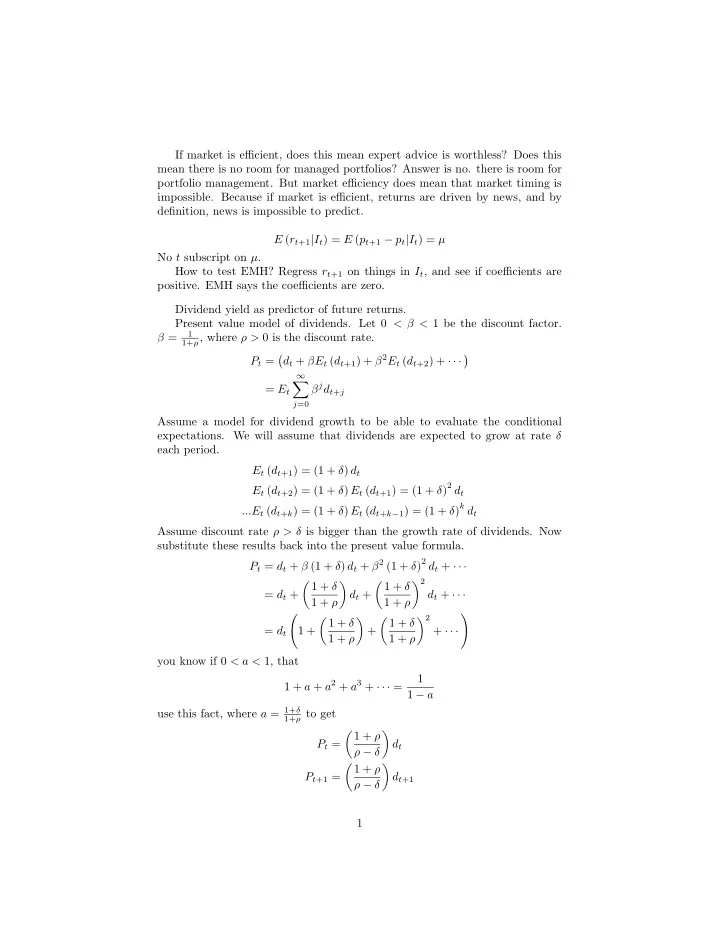

If market is efficient, does this mean expert advice is worthless? Does this mean there is no room for managed portfolios? Answer is no. there is room for portfolio management. But market efficiency does mean that market timing is impossible. Because if market is efficient, returns are driven by news, and by definition, news is impossible to predict. E ( r t +1 | I t ) = E ( p t +1 − p t | I t ) = µ No t subscript on µ. How to test EMH? Regress r t +1 on things in I t , and see if coefficients are positive. EMH says the coefficients are zero. Dividend yield as predictor of future returns. Present value model of dividends. Let 0 < β < 1 be the discount factor. 1 β = 1+ ρ , where ρ > 0 is the discount rate. � d t + βE t ( d t +1 ) + β 2 E t ( d t +2 ) + · · · � P t = ∞ � β j d t + j = E t j =0 Assume a model for dividend growth to be able to evaluate the conditional expectations. We will assume that dividends are expected to grow at rate δ each period. E t ( d t +1 ) = (1 + δ ) d t E t ( d t +2 ) = (1 + δ ) E t ( d t +1 ) = (1 + δ ) 2 d t ... E t ( d t + k ) = (1 + δ ) E t ( d t + k − 1 ) = (1 + δ ) k d t Assume discount rate ρ > δ is bigger than the growth rate of dividends. Now substitute these results back into the present value formula. P t = d t + β (1 + δ ) d t + β 2 (1 + δ ) 2 d t + · · · � 2 � 1 + δ � � 1 + δ = d t + d t + d t + · · · 1 + ρ 1 + ρ � � � 2 � 1 + δ � � 1 + δ = d t 1 + + + · · · 1 + ρ 1 + ρ you know if 0 < a < 1 , that 1 1 + a + a 2 + a 3 + · · · = 1 − a use this fact, where a = 1+ δ 1+ ρ to get � 1 + ρ � P t = d t ρ − δ � 1 + ρ � P t +1 = d t +1 ρ − δ 1
Take conditional expectations on both sides, � 1 + ρ � � 1 + ρ � E t ( P t +1 ) = E t ( d t +1 ) = (1 + δ ) d t ρ − δ ρ − δ divide both sides by P t , and we get � P t +1 � � 1 + ρ � (1 + δ ) d t E t = P t ρ − δ P t so we can run the regression � d t � r t,t +1 = α 1 + β 1 + ǫ t +1 P t � � 1+ ρ and the slope is estimating β 1 = (1 + δ ) . Now let’s look at ρ − δ � 1 + ρ � P t +2 = d t +2 ρ − δ � 1 + ρ � � 1 + ρ � (1 + δ ) 2 d t E t ( P t +2 ) = E t ( d t +2 ) = ρ − δ ρ − δ Divide both sides by P t, � P t +2 � � 1 + ρ � (1 + δ ) 2 d t E t = P t ρ − δ P t (1 + δ ) 2 . � � 1+ ρ so the dividend yield is a predictor of the 2 period return with coeffient ρ − δ We run the regression � d t � r t,t +2 = α 2 + β 2 + ǫ t +2 P t (1 + δ ) 2 , which is bigger than β 1 . � � 1+ ρ and the slope is β 2 = ρ − δ d t The punchline is that today’s dividend yield, P t should be a predictor of future returns and that the predicted returns get bigger as the future horizon gets longer. So let’s turn to the data to see how this works. � � P t +1 Let r t,t +1 = abstracting from dividends in the returns (i.e., dividends P t � � � � P t +2 P t +2 P t +1 are imputed into P t +1 ) . r t,t +2 = = = r t,t +1 r t +1 ,t +2 and so P t P t +1 P t forth, to r t,t +96 = r t,t +1 r t +1 ,t +2 , ..., r t +95 ,t +96 is the gross 96-month ahead gross return. We will look at regressions such as this, where we use the current dividend yield to forecast future returns, � d t � r t,t + k = α + β + ǫ t + k P t 2
slide 8 plots r t,t +12 against d t /P t . Slide 9 plots r t,t +96 against d t /P t → correlation is (+). High d t /P t predicts higher future returns. Reciprocal of dividend yield P t d t 3
Recommend
More recommend